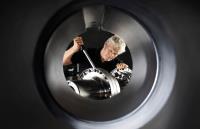 Add My Company
Add My Company
Sign In
Coupling Bore Tolerance Basics
07-11-2018

KTR provides a guide to bore and shaft tolerances and how they achieve acceptable levels of accuracy and ultimately to produce components that meet expectations and function in real world applications.
Before we get into the subjectively “bore-ing” world of tolerances, let’s consider a coupling application, such as a mine winder, involving extremely high torques, directional reversing, and bores nearing 1 meter in diameter. Now, let’s imagine that hub assembly onto the shafts is about to begin, but one of the bores is off by 0.003mm. Would this matter? The short answer is yes; even being off by three-thousandths of a millimetre can make a difference when it comes to bore and shaft tolerances.
What is Tolerance?
As seen in the tables below, a tolerance is the allowable amount above or below a nominal dimension and is used as a guide to achieve acceptable levels of accuracy and ultimately to produce components that meet expectations and function in real world applications.
One of the key challenges in dealing with bore tolerances stems from the fact that the exact measurements of parts cannot be guaranteed down to one-thousandth of a millimeter. It’s simply unattainable to produce exact results down to this type of measurement. This means a part (such as a shaft or hub bore) that is manufactured within the target dimensions is accepted, but one produced even slightly outside the allowed parameters will be rejected.
So, how exactly does industry function when limits to accuracy exist for bore and shaft tolerances? The answer lies in standardisation and industries acceptance of a specific level of known inaccuracy.
The table below is a small snapshot of machining standards for shaft and bore diameters, accepted throughout industry, in this case for steel hubs.
For more information on Coupling Bore Tolerance Basics talk to KTR U.K. Ltd
Enquire Now
List your company on FindTheNeedle.

